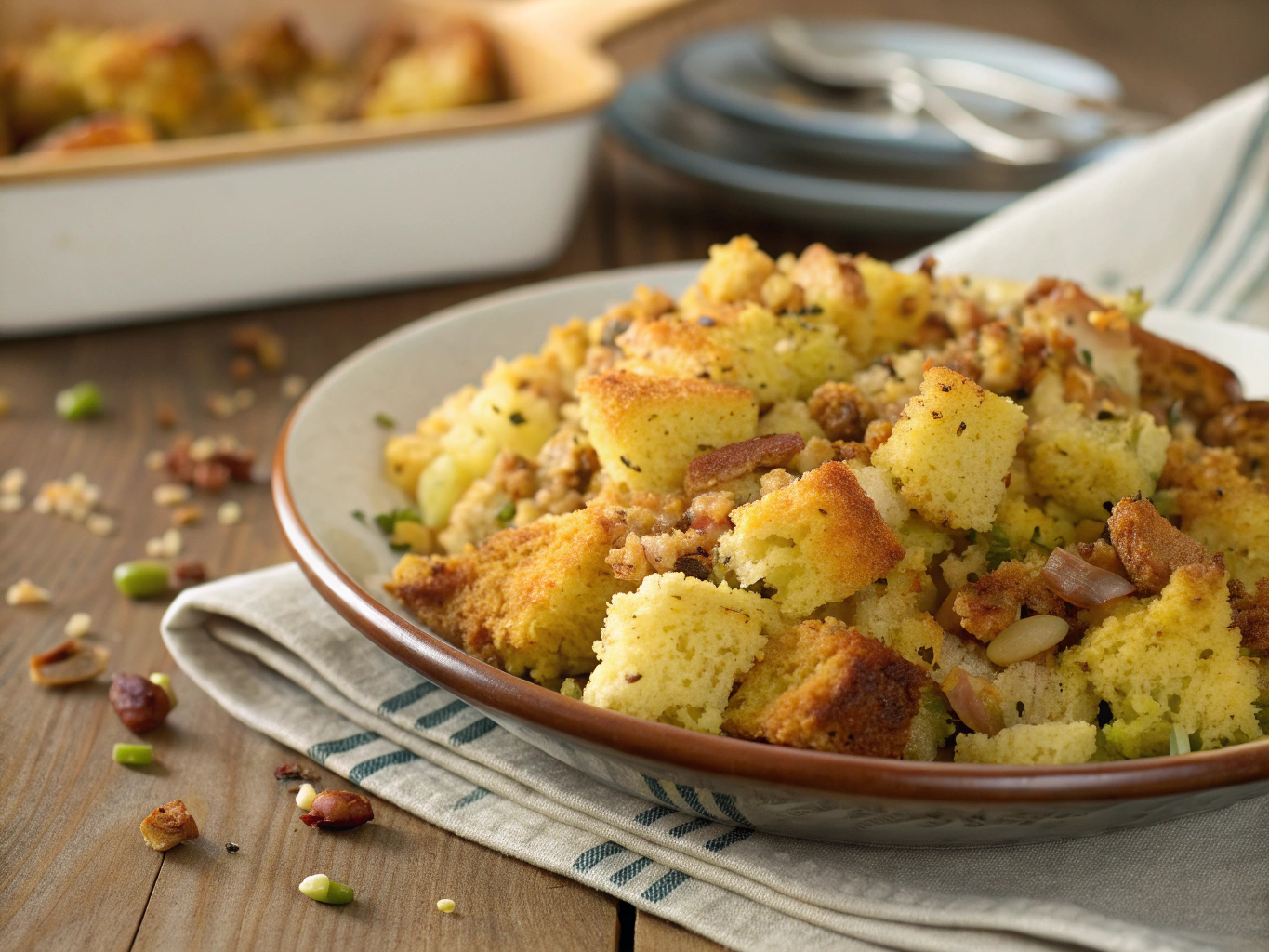
If you’re someone who craves comfort food with a creative twist, this cornbread stuffing recipe is going to hit all the right notes. In this article, I’ll walk you through my beloved recipe step-by-step and show you how to make it your own with smart swaps and flavorful additions. We’ll cover what makes a great cornbread stuffing, how to avoid common stuffing mistakes, and why so many cooks—new and seasoned—get excited about this dish. Whether you’re prepping for Thanksgiving or simply want a soul-satisfying side dish, this recipe belongs in your kitchen.
My Journey With Cornbread Stuffing: A Southern Tradition Reinvented
A Memory Baked in Cornbread
Every family has that one dish that defines their holiday table—and for mine, it was cornbread stuffing. Growing up in Charleston, the scent of my grandmother’s skillet-crisp cornbread mixing with sautéed onions and celery during the fall was enough to make me dance around her kitchen. I remember her never using a timer, instead relying on the “smell” to guide her. That’s how I learned to cook, too—by instinct. Cornbread stuffing wasn’t just a side. It was an edible memory that lingered long after the plates were cleared.
Years later, armed with curiosity and a cast iron pan, I started putting my own spin on her recipe. I added herbs she never used, introduced dried cranberries for pops of sweetness, and used smoked paprika to give it extra warmth. Now, I make a version that still respects hers but reflects my voice in the kitchen—and I can’t wait to share it with you.
Cornbread stuffing is often mistaken as just a Thanksgiving fixture, but it’s so much more. It’s deeply satisfying year-round because you can adjust it to match the season, your pantry, or your cravings. Whether baked alongside turkey or served next to grilled veggies, this stuffing will make you feel like you’re right back in Grandma’s warm kitchen.
Cornbread Stuffing: Comfort With a Twist
What makes cornbread stuffing special? It hits the sweet spot—literally and figuratively—between softness and crunch, between savory and sweet. Good cornbread stuffing doesn’t need extravagant ingredients. What it needs is balance: a crispy edge, a soft, tender center, and enough herbs and aromatics to pull it all together.
Where classic southern skillet meals lean into hearty, slow-cooked flavors, cornbread stuffing pairs that soulfulness with flexibility. For example, in our collard greens with garlic, we embrace bitter and bold flavors; in this stuffing, we focus on creamy richness with just enough texture to keep each bite interesting.
If you’ve only ever eaten boxed stuffing, this is your invitation to try something far more satisfying. Homemade cornbread stuffing is easier than it sounds and infinitely more delicious. All it takes is a little guidance and a good baking dish.
How to Make Cornbread Stuffing at Home
Ingredients List
The beauty of this recipe lies in the simplicity of its ingredients, each playing a role in texture or flavor. Here’s what you need to create a well-balanced pan of cornbread stuffing:
| Ingredient | Details |
|---|---|
| Cornbread | 6 cups, cubed and dried (homemade or storebought, unsweetened preferred) |
| Butter | ½ cup unsalted (or plant-based alternative like vegan butter) |
| Yellow Onion | 1 large, finely chopped |
| Celery | 2 stalks, chopped |
| Garlic | 2 cloves, minced |
| Vegetable Broth | 2 cups (low sodium) |
| Fresh Herbs | Sage, thyme, rosemary, finely chopped (about 1 tbsp total) |
| Optional Mix-ins | Dried cranberries, pecans, plant sausage, or apples |
Suggestions:
- Use day-old cornbread muffins to control moisture.
- Add in mushrooms or leeks when seasonal.
- Go vegan: olive oil + vegetable broth + nut-based stuffing binder.
Timing
From start to finish, this dish takes under 75 minutes:
- Prep time: 20 minutes
- Cooking time: 50–55 minutes
- Total time: ~75 minutes
That’s 15–20% shorter than many traditional bread stuffings. Make this on a Sunday, and you’ve got leftovers that reheat beautifully.
Step-by-Step Instructions
- Preheat your oven to 350°F. Lightly grease an 8×11 baking dish.
- In a large skillet, melt butter over medium heat. Add onion and celery. Cook for 5–7 minutes until soft. Stir in garlic and herbs and cook 1 minute more.
- In a large bowl, combine dried cubed cornbread and sautéed vegetables. Slowly add in broth while gently tossing. The cornbread should soak up moisture but not become mush.
- Fold in any optional extras like roasted apples or pecans.
- Spread mixture evenly in the greased dish and cover with foil.
- Bake for 30 minutes. Remove foil and bake another 20–25 minutes until golden and crisp on top.
- Let cool 5–10 minutes before serving.
Pro-tip: Dry your cornbread in the oven at 300°F for 15 minutes if it’s too moist.
Why This Cornbread Recipe Works
The Science of Texture and Flavor
What sets this cornbread stuffing apart is the attention to textural contrast. Soft, custard-like interiors nestle under crispy golden tops. Each bite carries the savory depth of aromatic herbs—balanced by the sweetness of well-baked cornmeal and butter.
According to Harvard’s nutrition resources, whole grain cornmeal offers a rich source of fiber and complex carbs. So, while stuffing often gets written off as an indulgence, using good-quality stone-ground cornmeal actually boosts its nutritional value and makes it a more rounded addition to your dinner table.
Variations Across Regions
In the South, what we lovingly call cornbread stuffing is often dubbed “cornbread dressing”—which typically gets baked separately from the bird. In some areas like Texas or Georgia, you’ll find it heavy on poultry seasoning or with a base of creamed corn. Up North, they may lean toward dryer textures or even mix it with white bread cubes.
Regardless of where you’re from, this recipe lets you steer the ship. Want it denser? Use less broth. Crave browner tops? Try convection for the last 10 minutes. Follow the adjustable steps, and you’ll lock down your family’s new favorite version.
For spicy lovers, consider bumping in that jalapeño vegan cornbread bake twist.
Tips, Mistakes to Avoid & Serving Ideas
Avoid These Stuffing Pitfalls
Let’s start with what not to do:
- Don’t use fresh cornbread—it turns to mush.
- Avoid overseasoning—cornbread absorbs more salt than you think.
- Skip stuffing it into the turkey. It cooks better on its own and prevents bacteria issues.
Always pre-saute your aromatics. Using raw onions in the mix results in harsh flavors and uneven cooking.
Pair Like a Pro
Cornbread stuffing plays nicely with a broad range of mains—from plant-based proteins to roasted meats. Try serving it alongside:
- Crispy tofu steaks with mushroom gravy
- Roasted squash or air-fried Brussels sprouts
- A vegan lentil loaf topped with tomato glaze
Want to make it brunch-worthy? Add chik’n sausage and scramble it into a breakfast bake. You’ll love it warm the next morning.
Frequently Asked Questions
What to put in cornbread stuffing?
Aromatic vegetables like onions, celery, and garlic form the flavor base. Add-ins like herbs (sage, thyme), veggie broth, pecans, dried cranberries, and even cooked sausage elevate the depth. Use dried cornbread to avoid sogginess.
What is the difference between cornbread stuffing and cornbread dressing?
Technically, stuffing is cooked inside a bird; dressing is baked separately. In the South, the terms are used interchangeably, though most “stuffings” down here are actually “dressings” by definition.
What are common stuffing mistakes to avoid?
People often use fresh bread (too soft), skip cooking aromatics (resulting in raw flavors), or over-saturate with broth. Also, underseasoning is a big mistake—cornmeal needs bold flavor companions. Taste and tweak before baking.
What ingredients are in cornbread dressing?
Cornbread, broth, onions, celery, garlic, herbs like sage and thyme, and optional mix-ins such as eggs, apples, sausage, or nuts. Moisture and flavor levels vary based on regional and personal preferences.
Conclusion
Cornbread stuffing is one of those iconic dishes that brings people to the table—no matter the season. With its satisfying texture and customizable flavor profile, it’s the kind of recipe I keep returning to and tinkering with year after year. Whether you’re hosting a holiday feast or just need a nostalgic pick-me-up, this version delivers big on comfort and creativity without overcomplicating your kitchen.
So grab that mixing bowl, trust your nose, and make it your own. Because great cooking isn’t about rules—it’s about joy. And that’s exactly what I hope this dish brings to your table.
